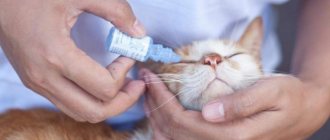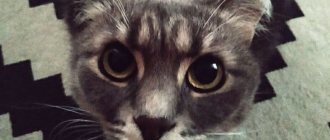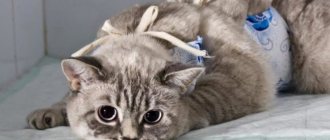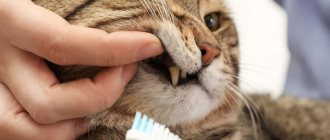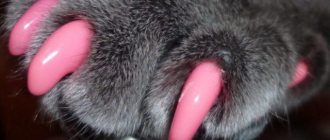For eye diseases in pets, experts most often prescribe drop therapy. Only a veterinarian at an appointment can competently explain how to put drops into a cat’s eyes. Knowing the features of instillation, you can perform the procedure yourself at home.
Typically, the doctor prescribes such procedures for several days, and instillation will need to be done two or three times during the day. Properly performed manipulation should not become an unpleasant procedure for the cat.
IMPORTANT! If 2 medications are prescribed, instillation should be carried out at intervals of 10-15 minutes. Means used simultaneously will not give a positive result.
Preparing the owner and cat for a medical procedure
Before the procedure, the animal owner must thoroughly wash their hands, disinfect them and wear gloves. There must be a mask on the face.
For a cat you need to prepare everything you need:
- warm boiled water;
- clean soft towel;
- a syringe without a needle or a pipette;
- 2 sterile cotton swabs (for each eye).
The drug must be removed from the cat's field of view. First, taking her in your arms, you need to calm her down, stroke her, and talk to her in a gentle voice. The animal must be securely restrained. A calm cat can be held in your arms or simply pressed lightly against the sofa. A restless one can be wrapped in a towel, leaving only the face visible.
It is good to attract an assistant who will hold the pet or instill medicine.
Features of the procedure
There are no fundamental differences in washing the eyes of an adult animal or a kitten: the procedure for performing the procedure is almost identical. The difference lies in small nuances that will help your pet as much as possible and not cause harm.
It all starts with preparing the necessary materials - you will need:
- several clean cotton pads or pieces of gauze;
- clean cloth napkins or towel;
- syringe without a needle (for copious rinsing);
- what you will use to wipe your cat’s eyes is a solution or decoction of herbs.
For aggressive or restless animals, a towel is useful - you can wrap the animal in it - or a retaining bag.
In adults
Adult cats may resist, so you will need an assistant to hold and calm the animal. The cat must be wrapped in a towel or blanket to gently hold it and not harm it during the procedure. Once the animal has been secured, you can begin washing.
First you need to soak the dried crusts, if any. After dipping a cotton pad into the medicinal solution, you need to squeeze the product into the sore eye and wait until the crusts become softer and easier to remove. Gently wipe the disc over the eyelid, being careful not to touch the cornea. Movements should be directed from the ears to the nose, towards the tear duct. Use different pads on different eyes to avoid infection of the healthy eye.
Once the eyes are clean, pour the medicinal solution onto the cornea of the eye using a syringe without a needle - if required by treatment. Normal hygienic cleaning can be left without this step. Remove any remaining solution around the eyelids with a dry cloth or towel. Do not press and try not to touch the eyeball with the tissue so as not to injure it or cause irritation.
How to wash a kitten's eyes
Kittens do not always cope well with washing themselves, as they are accustomed to the mother cat taking care of hygiene. In the first few months, the owner needs to regularly wash the baby’s eyes so that they do not begin to stick together and fester.
The whole manipulation is almost identical to what is done for an adult cat.
However, the procedure should be performed with extreme caution so as not to harm the small pet. You can do without an assistant - you can handle the baby yourself, especially if he is still sleepy
But after eating, you should not carry out the procedure - the kitten may vomit.
If, in addition to rinsing, there is a need to instill medicinal solutions or apply ointments, then precautions should be taken. Unlike adult cats, kittens should not have medicinal solutions put into their eyes immediately after rinsing: you must wait about ten minutes to minimize the risk of irritation.
If you have never owned a cat and do not know how and what to wash a kitten’s eyes with, contact your nearest veterinary clinic or an experienced breeder. You will quickly be shown all the steps of this easy and simple procedure.
Sequence of eye drops for a cat
Indications for eye treatment are pathological processes. For example, this is redness of the mucous membrane of the organ of vision, purulent discharge and gluing of the eyelids.
Before instilling medication into the eyes, you need to gently and carefully wipe the area around the eyes with swabs soaked in warm water to remove pus and other contaminants. Instead of water, you can use any warm tea or chamomile flower decoction.
Procedure:
- Rinse the mucous membranes of one eye first, and then the other with a cleansing solution. Remove wet residue.
- Open the tube with the pharmaceutical preparation.
- Slightly pull the eyelid down and squeeze 2-3 drops of the product into the resulting gap. During the procedure, you need to talk to the animal gently, this will calm him down.
- Massage the eyelid for 5-7 seconds for the best distribution of the medicine. The liquid should not leak onto the wool.
- Repeat the manipulation with the second eye. Do not let go of the animal for 2-3 minutes so that it does not scratch the eyeball.
The pet will feel itching or burning after the procedure. Sometimes the cat may feel severe pain. At this point she will become restless or even aggressive.
The animal needs to be rewarded with its favorite treat.
Is it possible to put human drops in a cat's eyes?
How to give eye drops to a cat?
Many people have pets that we take care of. But situations happen in life when your pet gets sick and this is very sad. And of all diseases, the most unpleasant and inconvenient disease to treat is eye disease. Most often, such diseases are very difficult and prevent the cat from enjoying life.
The eyes of a cat or cat can get sick for various reasons: bruises, injuries, debris stuck, previous diseases not treated and other reasons. Before starting treatment, all this must be taken into account. Because in order to get rid of and cure an insidious disease, you must first eliminate the cause of its occurrence.
Treating a cat is the same as treating a small capricious child. Your pet will not sit with his eyes open and wait until you finish all the procedures. It is quite natural that he will twitch, resist and run away. Therefore, to put drops in an animal’s eyes, you will have to work hard to catch him or her. And most likely it will not be so easy.
How to give eye drops to a cat? You caught your favorite cat, but at the same time you overturned all the furniture in the house, but this is just the beginning. To instill the drops themselves, you need medicine, a pipette and an assistant who will help hold your pet the way you need.
Be sure to warm the medicine before the procedure; you can simply hold it in your palms for a while, otherwise you yourself will understand what the cat’s reaction to the cold solution will be. Using gentle, gentle and careful movements, you must remove pus from the eyes, this must be done very carefully, and before the procedure itself, in order not to cause additional infection, you need to wash your hands. And if you have large nails, then ask another person to put drops in the animal, otherwise you may damage the cat's eye
Source
Animal care tips
When treating inflammatory eye diseases, animals are most often prescribed instillation - drip administration of solutions of medicinal agents. When instilling, it is necessary to correctly follow all the rules and recommendations of specialists on the administration of pharmaceuticals.
Only a veterinarian can prescribe medication correctly. A specialist should also monitor and adjust the dynamics of therapy. Uncontrolled or illiterate use of the drug can only worsen the situation. Medicines should not be expired.
Advice! The procedure should be carried out as naturally as possible, otherwise the animal will be scared and not allow the drops to be administered. The effectiveness of the manipulation will be much higher if the animal sits or lies in a calm state.
If the kitten cannot wash itself, then the owner should help it daily using boiled warm water or weak tea leaves.
Inflammation of the eyes is a common symptom in small kittens. A problem detected in time will help to avoid major health problems, and competent assistance will stop the development of the disease. The health of a pet primarily depends on its owner.
Diamond eyes
The antibacterial effect inherent in drops called Diamond Eyes is ensured by the inclusion of taurine and chlorhexidine in the structural formula. This drug quickly eliminates inflammatory foci that develop on the conjunctiva and helps cope with degenerative changes in the retina. This drug is often prescribed to a cat as a preventive measure when a predisposition to cataracts is identified.
Every day, our beloved pets spend a lot of time outside, interact with other animals, and therefore have every chance of contracting various infections. One of them is eye inflammation
It is very important to provide first aid in a timely manner without harming your pet, and promptly seek qualified help from a veterinarian in a specialized clinic for proper treatment.
But you shouldn’t self-medicate, since you don’t know exactly what your cat is sick with. Timely and correct treatment plays a huge role, since in advanced stages of the disease this can lead to a deterioration in your pet’s condition or loss of vision.
Redness of the eyeball
- is a consequence of vasodilation as a result of hemorrhages, for example, during injuries. This may indicate diseases such as conjunctivitis, blepharitis, keratitis, and iridocyclitis. And also a similar symptom tells us about an allergy to certain substances that we use.
Various discharge from the eyes (cloudy, bloody, serous, purulent).
Bloody issues
- most often, this is a sign of injury. The degree of damage and treatment should only be prescribed by a veterinarian. Do not try to remove foreign bodies yourself and reach deep into the cat’s eye, as this can seriously harm you. Entrust your animal to a professional.
Purulent and serous discharge
appear due to the proliferation of pathogenic organisms that release harmful waste products, which lead to the formation of discharge. And also, this is a symptom of injuries in which an infection penetrates into the eyeball or a manifestation of colds, but then the symptoms go away quickly and painlessly, but if there is a lot of discharge, you urgently need to see a doctor for help.
Presence of film on the eyes
- it can be bluish or white. This may be the manifestation of inflammation, which occurs as a result of infection.
Severe swelling of the eyelids
- a symptom of allergic reactions.
Excessive lacrimation and frequent scratching of the cat's eyes -
A common cause is a disease such as conjunctivitis. This disease causes inflammation of the connective tissue around the eyes. Caused by a bacterial infection.
Squinting of the eyes due to pain, photophobia -
this means that your cat or kitten is experiencing severe pain and discomfort in the eye area. They cause similar sensations of erosion and ulcers. They manifest themselves as clouding of the cornea, the presence of a cloudy film on the eye. These diseases occur extremely quickly and can lead to serious complications or complete loss of vision.
Cloudiness of the lens -
speaks of the beginning of a serious disease called cataracts. Symptoms of this disease may not be immediately noticed, but subsequently the dog or cat gradually loses its vision. The main sign of the development of cataracts is a change in the color of the pupil.
General weakness and lethargy, loss of appetite
- these general signs should also make you wary and draw closer attention to your beloved pet. There are a lot of symptoms, so to determine the disease and treatment methods for your pet, only a veterinarian can determine
There are a lot of symptoms, so only a veterinarian can determine the disease and treatment methods for your pet.
Common diseases
Classification of eye pathologies in cats, symptoms characteristic of each disease:
| Disease | Description and symptoms |
| Conjunctivitis | Occurs due to the entry of a foreign body, trauma to the mucous membrane, exposure to chemicals, and diseases of infectious origin. Characterized by swelling in the eyelid area and a large volume of purulent discharge. The disease can be transmitted from a sick cat to a healthy one. |
| Glaucoma | An increase in pressure in the eyeball can cause clouding of the cornea. The pathology often causes blindness. |
| Keratitis | Inflammation of the cornea is observed with clouding of the mucous membrane of the eyes and increased tearing. |
| bulging eye | Protrusion of an organ occurs due to its damage or the development of a neoplasm. Pathology is fraught with organ loss. |
| Violation of the lacrimation process | Blockage of the tear duct, as well as excessive secretion of fluid. The animal experiences severe discomfort, and the ability to see deteriorates. |
| Cataract | Characterized by clouding of the lens. The eye becomes smoky usually in adult animals and cats suffering from diabetes. |
To prevent the development of any eye disease, a systematic examination of your pet by a veterinarian is required. Without timely treatment, not only a malfunction of the visual system is possible, but also an increased risk of vision loss.
Medicines for chronic conjunctivitis
Chronic conjunctivitis, as a rule, means irritation and inflammation of the conjunctiva caused by prolonged exposure to harmful physical or chemical factors, or active foci of chronic infection in other organs.
Against the background of long-existing inflammation, the composition of the tear film and the amount of tears changes, and dry eye syndrome (DES) develops, which over time can develop into a severe form - corneal-conjunctival xerosis. In this case, epithelial defects occur (recurrent erosion), and a corneal ulcer may develop (a serious disease that threatens complete blindness).
Therefore, it is important not only to treat the cause of conjunctivitis, but also to use tear substitutes.[1]
Fig. 4 Tear substitutes (moisturizing drops) used for chronic conjunctivitis
“Cationorm” is a unique cationic emulsion that is suitable for people with glaucoma, blepharitis, allergic conjunctivitis and people using hormone replacement therapy (menopausal hormones, oral contraceptives). The drug restores all three layers of tears and prevents itching and redness of the eyes. Cationorm helps with severe pain and dryness in the eyes that appears in the morning, and quickly relieves discomfort. Drops can be applied directly to lenses. Drops should be used 1-2 drops into the eye sac 1-4 times a day.[2]
"Ocutiarz" - eye drops based on hyaluronic acid (a natural component of human tears) with an ultra-high molecular weight help to quickly relieve dryness and eliminate pain in the eyes that occurs occasionally after prolonged visual work (computer syndrome in office employees, motorists/motorcyclists, frequent fliers , travelers, students). In addition, the drops are suitable for people after ophthalmic surgery and people who have recently worn contact lenses. They do not contain preservatives and can be in direct contact with lenses. Directions for use: 1-4 times a day, 1 drop.[3]
“Oftagel” is an eye gel with carbomer in maximum concentration that moisturizes the ocular surface for a long time, eliminates pain and lacrimation of the eyes, and does not require frequent instillation; it can be used once a day as a means of additional eye hydration. Suitable for people who do not have the opportunity or desire to use drops during the day. Use 1 drop of the drug 1 – 4 times a day, depending on the severity of symptoms.[4]
In conclusion, the following points need to be emphasized:
Modern drugs used in ophthalmology, as a rule, have a wide spectrum and combined nature of action, so the same medicine can be prescribed for different types and forms of conjunctivitis. On the other hand, each variant of the inflammatory process requires a special approach - for example, a herpes viral infection is treated slightly differently than a “simple” adenoviral infection.
Further, there are very dangerous, but statistically rarer, or not typical for our latitudes forms of conjunctivitis - parasitic, epidemic Koch-Wicks, etiologically unclear, mixed (involving the cornea, eyelids, etc.) - therapy for which is beyond the scope of this article.
Finally, many of the drugs described above have absolute or relative contraindications, i.e. should be excluded or prescribed in sparing dosages (or under special medicinal cover) in the treatment of conjunctivitis in such categories of patients as children, pregnant or lactating women, people with weak immunity, patients with severe somatic pathology, etc. Considering the huge number of such clinical, therapeutic , pharmacological nuances, any attempts at self-medication, incl. "folk" means. Conjunctivitis of any genesis (origin) is not as harmless as it seems to many; in some cases, it poses a direct danger to vision, which is why timely seeking ophthalmological help is so important.
Material prepared by: Sagonenko Dmitry Alekseevich
Ophthalmologist, site consultant
List of sources used
- Kovalevskaya M.A., Maychuk D.Yu., Brzhesky V.V. Red eye syndrome. Practical guide for ophthalmologists. Moscow, 2010
- Brzhesky V.V., Algorithm for choosing tear replacement therapy in patients in outpatient practice, Clinical Ophthalmology 2021, No. 1
- Instructions for use of Ocutiarz® ophthalmic moisturizing solution
- Maychuk Yu. F., Yani E. V., Maychuk D. Yu. Artificial tear preparation Oftagel in the treatment of dry eye syndrome after epidemic keratoconjunctivitis / Breast Cancer “Clinical Ophthalmology”, No. 4 of November 12, 2001, p. 172.
- Back
- Forward
Add a comment
How to wash the eyes of a kitten or cat as a preventive measure
It is recommended to monitor the condition of your cat's eyes from an early age. Newborn kittens' eyes open after one to two weeks.
If by the end of the third week the eyes have not opened, you need to wash them very carefully
Adult cats take care of their own hygiene. The daily cat ritual includes washing the face and eyes. But it happens that the cat gets hurt or catches a disease - to prevent complications, periodically examine your pet. If you notice clouding or change in color of the iris, purulent discharge, or fur on the face with traces of tears, then immediately contact your veterinarian. If an injury is detected, do not let the animal rub its eye, as this irritates the mucous membrane. Do not open your pet's eyes by force. Do not use medications containing prednisolone or dexamethasone yourself - you may worsen the situation.
The treating veterinarian will advise what to wash your cat's eyes with as a preventive measure. You can soak a cotton pad with strong tea or saline solution, and then clean the eye with smooth movements. All this is necessary if the cat periodically develops brown crusts - the consequences of poor hygiene and dust getting on the cornea. This is not dangerous if the accumulations are removed from the tear corners in time.
Do not forget to vaccinate your animal once a year, without losing track of the schedule. If you have an elderly or frail pet, take it to the veterinarian regularly.
In the case when simple medications do not help and your pet’s eyes continue to fester, become swollen and stick together, it is necessary to take the animal to the veterinarian. The doctor will make an accurate diagnosis and prescribe age- and breed-appropriate treatment.
The article is of a recommendatory nature. Consult your veterinarian!

